
The early influence of the London Missionary Society on the Griquas
Tigers Eye - "Griquatown Gold" the industry of the Griqua
people in Griquatown today
Pictorial History of early settlements around Griquatown with Maps and Videos
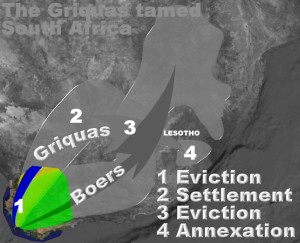 |
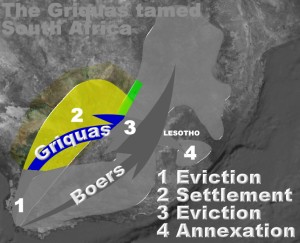 |
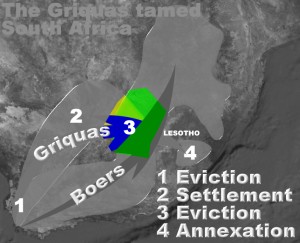 |
Previous Page |
The history of the Griquas in a map (click) |
Next Page |
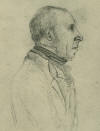 The early influence of the London Missionary Society on the Griquas:
The early influence of the London Missionary Society on the Griquas:
By the late 1700s the Griquas, made up of a multiracial mix of men and women evicted from the Cape, settled a large tract of land in central South Africa north of the Orange river and extending far beyond Griquatown, Kimberley and Philippolis to the east - collectively known as Griqualand West. (Much of this area is now known as the Orange Free State). Interestingly the famous Augrabies Falls on the Orange River to the west of Griqua Town gets its name from the Hottentot word, Ankoerebis, (place of big noises). The Hottentots and Bastards believe that evil spirits were active here. See map for geographical areas occupied by the Griquas. In 1801 William Anderson (seen right) established a London Missionary Society mission at Aakaap and then, later, at Klaarwater (later Griqua Town - see below).
The Descendants of William Anderson of Griquatown now have a web page.
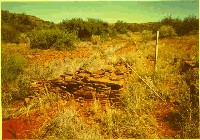 William Burchell visited Klaarwater in October 1811 and
reported that: "The trees of my imagination vanished,
leaving nothing in reality but a few which the missionaries themselves had
planted; the church sunk to a barn-like building of reeds and mud; the village
was merely a row of half a dozen reed cottages; the river was but a rill;
and the situation an open, bare, and exposed place, without any appearance
of a garden, excepting that of the missionaries."
William Burchell visited Klaarwater in October 1811 and
reported that: "The trees of my imagination vanished,
leaving nothing in reality but a few which the missionaries themselves had
planted; the church sunk to a barn-like building of reeds and mud; the village
was merely a row of half a dozen reed cottages; the river was but a rill;
and the situation an open, bare, and exposed place, without any appearance
of a garden, excepting that of the missionaries."
Image right: The 1812 grave site of the wife of Cornelius Kramer one of the first missionaries to minister to the Griquas
William J Burchell's
woodcut vignettes
and comments on Griqua life (October 1811)
|
In 1813 the Rev John Campbell, a director of the London Missionary Society
visited Klaarwater and put in process the renaming of what had become the
world's first multiracial tribe. They took on the name "Griqua" after a Hottentot
tribe the "Gurigriqua" - and the renaming of Klaarwater to Griqua town
(a
historic town which survives today). For many years the
Griqua bergenaars, armed with rifles and riding horses, laid siege to this
part of Southern Africa and north of the Vaal river killing the nomadic Bushmen,
participating in hunting parties and stupidly taking on the expanding Zulu
forces under Shaka (an act which resulted in great loss of life).
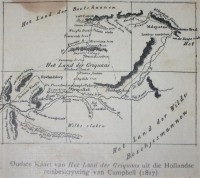
Image right: One of the first known maps of Griqua lands around Griquatown dating back to 1817 - found in the extremely rare Afrikaans booklet Jubelfees-gedenkboek van die (NGK) Gemeente Grikwastad.
The earliest map of this region, found in Burchell's "Travels in the interior of South Africa" can be seen at this link.
 During this
time the missionary Rev John Campbell was attributed by Alexander Parsons
with producing
four coins to be used by the Griquas. The bronze 1/4; 1/2 and
silver IIIII; 10 coins are today extremely rare
(see image
of the four coins at this link). However, the coins were never used
by the Griquas despite wide spread claims by numismatists in the past that
they were. These erroneous views were based on the
Parsons' flawed
research published in 1927. These Griqua Town pieces were nothing
more than failed token coins
struck in about 1819 - they never circulated although the resident missionary at Griquatown, Helms, talks about keeping them in a bag in 1820. Campbell's
drunken fantasies are exposed by a
fellow Missionary, Robert Moffat - see this
link.
During this
time the missionary Rev John Campbell was attributed by Alexander Parsons
with producing
four coins to be used by the Griquas. The bronze 1/4; 1/2 and
silver IIIII; 10 coins are today extremely rare
(see image
of the four coins at this link). However, the coins were never used
by the Griquas despite wide spread claims by numismatists in the past that
they were. These erroneous views were based on the
Parsons' flawed
research published in 1927. These Griqua Town pieces were nothing
more than failed token coins
struck in about 1819 - they never circulated although the resident missionary at Griquatown, Helms, talks about keeping them in a bag in 1820. Campbell's
drunken fantasies are exposed by a
fellow Missionary, Robert Moffat - see this
link.
Over 50 practical, logical, research-based findings exposing the Griquatown coin fallacy are summarised at this link. The findings are supported by eminent South African historians like Prof Arndt and Karel Schoeman. Remarkably a few "head in the sand" coin collectors in South Africa continue to believe in the numismatic equivalent of the debunked " world is flat" theory - still claiming (in 2009) that the Griquatown token coins were South Africa's first circulating currency and actually circulated! This is years after the evidence to the contrary continues to be ignored by them.
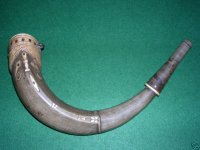 In
1814 William Anderson lost the respect of the Griqua people gather at Griqua
Town after he bowed to the wishes of the British Colony and tried to persuade
20 young Griquas staying there to enroll in the Colonial forces. The Griquas
hated a regimented lifestyle and preferred hunting in groups on horses -
calling themselves "Bergenaars"..
In
1814 William Anderson lost the respect of the Griqua people gather at Griqua
Town after he bowed to the wishes of the British Colony and tried to persuade
20 young Griquas staying there to enroll in the Colonial forces. The Griquas
hated a regimented lifestyle and preferred hunting in groups on horses -
calling themselves "Bergenaars"..
Image right: An extremely rare Griqua Buffalo Horn Powder Flask in the Balson Holdings Family Trust (more at this link).
As a result Anderson would never regain his important and trusted position in the community. In fact the main families like Kok and Barends left Griqua Town and set up their nomadic bases at Daniels Kuil and Campbell leaving Anderson with just a few transient Griquas and no stable village population. This was a year before the Griqua Town coins were supposed to have circulated there. J S Marais notes in his book The Cape Coloured People 1652-1932, During this time (1815-1820) Griquatown became a ghost town with the few nomadic Griquas using the station as a temporary camp before moving on.
Image right above: An artist drawing of a Griqua
family home at Griqua town in 1834 - nearly 20 years after the Griquas were
supposed to have been advanced enough to understand how to use coins - I
don't think so! (See the
comments of Dr F K Mitchell S Africa's best known numismatist on this
point).
What is of interest is that the above letter was written by Campbell just nine months before he embarked on his first trip to S Africa (24th June 1812) on the boat Isabella. |
In 1814 the Prince of Orange sold the Cape to Great Britain for £6,000,000 against the wish and will of the Dutch settlers.
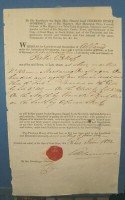 The famous Voortrekker Piet Retief had a debt
of 249 rijx dollars, nearly twenty pounds, to a slave incurred in January
1827 that he was unable to repay. The debt was for 141 sheep and 30 goats
that Retief bought from the female slave. The debt was witnessed by several
people including the slave's master and Retief's debt and his inability to
pay is well documented in the Cape Archives.
The famous Voortrekker Piet Retief had a debt
of 249 rijx dollars, nearly twenty pounds, to a slave incurred in January
1827 that he was unable to repay. The debt was for 141 sheep and 30 goats
that Retief bought from the female slave. The debt was witnessed by several
people including the slave's master and Retief's debt and his inability to
pay is well documented in the Cape Archives.
Image right: The original title deed granted to Voortrekker leader Pieter Retief in 1823 now in the Balson Holdings family Trust collection - more at this link.
In 1834 when the emancipation of the slaves in the Cape became law many settlers went bankrupt because their slaves had been used as security against loans to banks and their compensation from the British Government was a fraction of the slave's "value". In 1823 a figure of over twelve million guilders had been loaned by banks against 4,089 slaves (mainly Hottentots/Bastards)! The compensation the settlers received was a fraction of their mortgaged value… leading to the bankruptcies. Another interesting fact is that for over 20 years after the emancipation of the slaves labour intensive production on white farms in the Cape like wine making and grain harvesting dropped off dramatically (to about one third) while wool production (many slaves owned sheep) rose from just over 50,000lbs to over 3.2 million lbs.
It was the emancipation of the slaves in the Cape that led to the Great Trek as the boers moved north of the Orange river so that they would not fall under the jurisdiction of the British Governor of the Cape.
Theale wrote, "There were to be seen (post-1834) families reduced from affluence to want, widows and orphans made destitute, poverty and anxiety brought into hundreds of homes. A number of these freed slaves joined the Griquas at Philippolis."

1826 - Receipt for Slaves from the Slave Registry
Office - image right
|
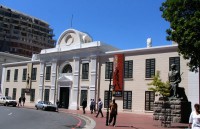 The Slave Lodge was built in 1679, making it the second oldest existing colonial
structure of the Cape Colony, today part of South Africa. This building was
changed many times and it is unclear how much of the existing building dates
from the slave period.
The Slave Lodge was built in 1679, making it the second oldest existing colonial
structure of the Cape Colony, today part of South Africa. This building was
changed many times and it is unclear how much of the existing building dates
from the slave period.
Image right: The historic Slave Lodge in Cape Town
The building was used as a slave lodge until 1811 when it was changed into government offices by the new British colonial authorities. Britain occupied the Cape Colony in 1806 and their claim to the Cape was recognised in 1814 by the rest of Europe.
The Slave Lodge housed the slaves who belonged to the Dutch East India Company (VOC). These slaves worked for the VOC and were never sold. Very little is known of the people who lived in the Lodge, We know what type of work they did and we know something of conditions in which the lived. We have managed to find at least half of their names, but know little more than where they came from and the date of their death.
The British colonial government decided to turn the Slave Lodge into government offices in 1807. At that stage there were 283 slaves in the Lodge: 187 men, 73 women and 23 children. Many of these slaves were old and could not work anymore. The governor, the Earl of Caledon, sold some of slaves at a public auction and the remaining slaves were moved into the western wing of the Lodge. In 1811, the remaining slaves were moved to a rented building and in 1820 to a new slave lodge in the Gardens. These 135 slaves were manumitted in 1828, six years before universal emancipation of slaves in the British Empire.
Today the Slave Lodge is a museum, managed by Iziko Museums of Cape Town. It became a cultural history museum in 1966, exhibiting mainly the material culture of the descendents of the Dutch and British colonists.
The role that slaves played in developing the Cape Colony was only fully recognised by the museum during the 1990s. The building was renamed the Slave Lodge on Heritage Day, 1998. Work is in progress to develop a museum of slavery in the building.
 Tigers Eye - "Griquatown Gold" the industry
of the Griqua people in Griquatown today
Tigers Eye - "Griquatown Gold" the industry
of the Griqua people in Griquatown today
In Griquatown today there is only one viable industry from the Griqua ancestors of Adam Kok. This is the mining of Tiger's Eye which takes place in the rocky hills just a few kilometers from the small town.
The images below are of two very large pieces purchased by the Balson Holdings Family Trust from the Griquas mining the stone in September 2006 are about one inch thick.
More about Scott Balson's 2006 trip to Griquatown
at this
link.
More about Scott Balson's 2007 trip to Griquatown
at this
link.
 |
 |
 |
Two pieces of tiger eye |
weighing several kilos - purchased | at the Griquatown mines |
Video Clip of the tigers eye mines at Griquatown (2007)